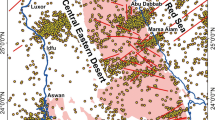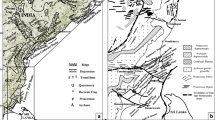Abstract
We investigated the deformation in the accretionary wedge associated with subducted seamounts in the northern Manila Trench by combining observations from seismic profiles and results from laboratory sandbox experiments. From three seismic reflection profiles oriented approximately perpendicular to the trench, we observed apparent variations in structural deformation along the trench. A number of back-thrust faults were formed in the accretionary wedge where subducted seamounts were identified. In contrast, observable back-thrusts were quite rare along the profile without seamounts, indicating that seamount subduction played an important role in deformation of the accretionary wedge. We then conducted laboratory sandbox experiments to investigate the effects of subducted seamounts on the structural deformation of the accretionary wedge. From the analog modeling results we found that seamount subduction could cause well-developed back-thrusts, gravitational collapse, and micro-fractures in the wedge. We also found that a seamount may induce normal faults in the wedge and that normal faults may be eroded by subsequent seamount subduction. In addition, we constrained the crustal structure of the South China Sea plate from modeling free-air gravity data. The dip angle of the subducting plate, which was constrained by hypocenters of available earthquakes, increased from south to north in the northern Manila Trench. We found a laterally heterogeneous density distribution of the oceanic crust according to the gravity data. The density of subducted crust is ~2.92 g/cm3, larger than that of the South China Sea crust (2.88 g/cm3).









Similar content being viewed by others
References
Ahrens TJ, Schubert G (1975) Gabbro-eclogite reaction rate and its geophysical significance. Rev Geophys Space Phys 13:383–400
Ballance PF, Scholl DW, Vallier TL, Stevenson AJ, Ryan H, Herzer RH (1989) Subduction of a late cretaceous seamount of the Louisville chain at the Tonga Trench: a model of normal and accelerated tectonic erosion. Tectonics 8:953–962
Byerlee J (1978) Friction of rocks. Rock Frict Earthq Predict 116:615–626
Chai BHT (1972) Structure and tectonic evolution of Taiwan. Am J Sci 272:389–422
Chemenda AI, Mattauer M, Malavieille J, Bokun AN (1995) A mechanism for syn-collisional rock exhumation and associated normal faulting: results from physical modelling. Earth Planet Sci Lett 132:225–232
Chemenda A, Yang R, Hsieh C-H, Groholsky A (1997) Evolutionary model for the Taiwan collision based on physical modelling. Tectonophysics 274:253–274
Ding W, Yang S, Chen H, Cheng X, Wu N (2006) Arc-continent collision orogeny in offshore Taiwan during Neogene. Chin J Geol 41:195–201 (in Chinese)
Dominguez S, Lallemand S, Malavieille J, von Huene R (1998) Upper plate deformation associated with seamount subduction. Tectonophysics 293:207–224
Dominguez S, Malavieille J, Lallemand S (2000) Deformation of accretionary wedges in response to seamount subduction: insights from sandbox experiments. Tectonics 19:182–196
Fuis GS, Moore TE, Plafker G, Brocher TM, Fisher MA, Mooney WD (2008) Trans-Alaska Crustal Transect and continental evolution involving subduction underplating and synchronous foreland thrusting. Geology 36:267–270
Gao X, Zhang J, Sun YJ, Wu SG (2012) A simulation study on the thermal structure of Manila Trench subduction zone. Chin J Geophys 55(1):117–125 (in Chinese)
Geist EL, Fisher MA, Scholl DW (1993) Large-scale deformation associated with ridge subduction. Geophys J Int 115:344–366
Gutscher M-A, Maury R, Eissen J-P, Bourdon E (2000) Can slab melting be caused by flat subduction? Geology 28:535–538
Gutscher M-A, Malod J, Rehault J-P, Contrucci I, Klingelhoefer F, Mendes-Victor L (2002) Evidence for active subduction beneath Gibraltar. Geology 30:1071–1074
Huang CY, Wu WY, Chang CP, Tsao S, Yuan PB, Lin CW (1997) Tectonic evolution of accretionary prism in the arc-continent collision terrane of Taiwan. Tectonophysics 281:31–51
Huang CY, Xia K, Yuan PB, Chen PG (2001) Structural evolution from Paleogene extension to Latest Miocene-Recent arc-continent collision offshore Taiwan: comparison with on land geology. J Asian Earth Sci 19:619–639
Huang C-Y, Yuan PB, Tsao S-J (2006) Temporal and spatial records of active arc-continent collision in Taiwan: a synthesis. Geol Soc Am Bull 118:274–288
Kao H, Huang GC, Liu CS (2000) Transition from oblique subduction to collision in the northern Luzon arc-Taiwan region: constraints from bathymetry and seismic observations. J Geophys Res Solid Earth (1978–2012) 105:3059–3079
Konstantinovskaia E, Malavieille J (2005) Erosion and exhumation in accretionary orogens: experimental and geological approaches. Geochem Geophys Geosyst 6:Q02006
Koopman A, Speksnijder A, Horsfield W (1987) Sandbox model studies of inversion tectonics. Tectonophysics 137:379–388
Krantz RW (1991) Measurements of friction coefficients and cohesion for faulting and fault reactivation in laboratory models using sand and sand mixtures. Tectonophysics 188:203–207
Ku C-Y, Hsu S-K (2009) Crustal structure and deformation at the northern Manila Trench between Taiwan and Luzon islands. Tectonophysics 466:229–240
Kukowski N, Von Huene R, Malavieille J, Lallemand S (1994) Sediment accretion against a buttress beneath the Peruvian continental margin at 12 S as simulated with sandbox modeling. Geol Rundsch 83:822–831
Kukowski N, Lallemand SE, Malavieille J, Gutscher M-A, Reston TJ (2002) Mechanical decoupling and basal duplex formation observed in sandbox experiments with application to the Western Mediterranean Ridge accretionary complex. Mar Geol 186:29–42
Lewis SD, Hayes DE (1984) A geophysical study of the Manila Trench, Luzon, Philippines: 2. Fore arc basin structural and stratigraphic evolution. J Geophys Res Solid Earth (1978–2012) 89:9196–9214
Li Q, Jian Z, Li B (2004) Oligocene–Miocene planktonic foraminifer biostratigraphy, Site 1148, Northern South China Sea. In: Prell WL, Wang P, Blum P, Rea DK, Clemens SC (eds) Proceedings of the ocean drilling program, scientific results, vol 184. pp 1–26
Li C, Zhou Z, Li J, Chen H, Geng J, Li H (2007) Precollisional tectonics and terrain amalgamation offshore southern Taiwan: characterizations from reflection seismic and potential field data. Sci China, Ser D Earth Sci 50:897–908
Lohrmann J, Kukowski N, Adam J, Oncken O (2003) The impact of analogue material properties on the geometry, kinematics, and dynamics of convergent sand wedges. J Struct Geol 25:1691–1711
Mao S, Wu G, Li J (2004) Oligocene–early Miocene dinoflagellate stratigraphy, Site 1148, ODP Leg 184, South China Sea. In: Prell WL, Wang P, Blum P, Rea DK, Clemens SC (eds) Proceedings of the ODP, science results, vol. 184. Ocean Drilling Program, College Station, TX, pp 1–29
McIntosh K, Nakamura Y, Wang T-K, Shih R-C, Chen A, Liu C-S (2005) Crustal-scale seismic profiles across Taiwan and the western Philippine Sea. Tectonophysics 401:23–54
Moore JC, Mascle A, Taylor E, Andreieff P, Alvarez F, Barnes R (1988) Tectonics and hydrogeology of the northern Barbados Ridge: results from Ocean Drilling Program leg 110. Geol Soc Am Bull 100:1578–1593
Pautot G, Rangin C (1989) Subduction of the South China Sea axial ridge below Luzon (Philippines). Earth Planet Sci Lett 92:57–69
Peacock SM (1993) Large-scale hydration of the lithosphere above subducting slabs. Chem Geol 108:49–59
Peacock SM, Wang K (1999) Seismic consequences of warm versus cool subduction metamorphism: examples from southwest and northeast Japan. Science 286:937–939
Pedley KL, Barnes PM, Pettinga JR, Lewis KB (2010) Seafloor structural geomorphic evolution of the accretionary frontal wedge in response to seamount subduction, poverty indentation, New Zealand. Mar Geol 270:119–138
Persson KS, Sokoutis D (2002) Analogue models of orogenic wedges controlled by erosion. Tectonophysics 356:323–336
Ranero CR, von Huene R (2000) Subduction erosion along the Middle America convergent margin. Nature 404(6779):748–752
Sandwell DT, Smith WHF (2009) Global marine gravity from retracked Geosat and ERS-1 altimetry: ridge segmentation versus spreading rate. J Geophys Res 114:B01411
Shemenda AI (1993) Subduction of the lithosphere and back arc dynamics: insights from physical modeling. J Geophys Res Solid Earth (1978–2012) 98:16167–16185
Sibuet JC, Hsu SK (1997) Geodynamics of the Taiwan arc-arc collision. Tectonophysics 274:221–251
Taylor B, Hayes DE (1983) Origin and history of the South China Sea basin. Geophys Monogr Ser 27:23–56
van Hunen J, Van Den BERGAP, Vlaar NJ (2002) On the role of subducting oceanic plateaus in the development of shallow flat subduction. Tectonophysics 352:317–333
von Huene R, Scholl D (1993) The return of sialic material to the mantle indicated by terrigeneous material subducted at convergent margins. Tectonophysics 219:163–175
Wang K, Bilek SL (2011) Do subducting seamounts generate or stop large earthquakes? Geology 39:819–822
Wang P, Prell WL, Blum P, Arnold EM, Buehring CJ, Chen M-P, Clemens SC, Clift PD, Colin CJG, Farrell JW, Higginson MJ, Jian Z, Kuhnt W, Laj CE, Lauer-Leredde C, Leventhal JS, Li A, Li Q, Lin J, McIntyre K, Miranda CR, Nathan SA, Shyu J-P, Solheid PA, Su X, Tamburini F, Trentesaux A, Wang L (2000) In: Proceedings of the ocean drill program, Initial Rep 184. Ocean Drilling Program, College station, TX
Watts AB, Koppers AAP, Robinson DP (2010) Seamount subduction and earthquakes. Oceanography 23:166–173. doi:10.5670/oceanog.2010.68
Yang TF, Lee T, Chen C-H, Cheng S-N, Knittel U, Punongbayan RS (1996) A double island arc between Taiwan and Luzon: consequence of ridge subduction. Tectonophysics 258:85–101
Yang H, Zhu L, Chu R (2009) Fault-plane determination of the 18 April 2008 Mt. Carmel, Illinois, earthquake by detecting and relocating aftershocks. Bull Seismol Soc Am 99(6):3413–3420. doi:10.1785/0120090038
Yang H, Liu Y, Lin J (2012) Effects of subducted seamounts on megathrust earthquake nucleation and rupture propagation. Geophys Res Lett 39:L24302. doi:10.1029/2012GL053892
Yang H, Liu Y, Lin J (2013) Geometrical effects of a subducted seamount on stopping megathrust ruptures. Geophys Res Lett 40:2011–2016. doi:10.1002/grl.50509
Yi H, Zhong G, Ma J (2008) Fracture characteristics and basin evolution of the Taixinan basin in Cenozoic. Pet Geol Exp 29:560–564 (in Chinese)
Yu H-S, Huang Z-Y (2009) Morphotectonics and sedimentation in convergent margin basins: an example from juxtaposed marginal sea basin and foreland basin, Northern South China Sea. Tectonophysics 466:241–254
Acknowledgments
This manuscript benefited from valuable discussions and comments from Ning Qiu, Jian Lin, Di Zhou and Lu Wang. We thank guest editor Peter Clift, the reviewers Hongfeng Yang and Fabio Caratori Tontini for their constructive comments that significantly improved the manuscript. This work is supported by the Major National Science and Technology Program (No. 2011ZX05025-003-005), and the Major Research plan of National Science Foundation of China (No. 91028007).
Author information
Authors and Affiliations
Corresponding author
Rights and permissions
About this article
Cite this article
Li, F., Sun, Z., Hu, D. et al. Crustal structure and deformation associated with seamount subduction at the north Manila Trench represented by analog and gravity modeling. Mar Geophys Res 34, 393–406 (2013). https://doi.org/10.1007/s11001-013-9193-5
Received:
Accepted:
Published:
Issue Date:
DOI: https://doi.org/10.1007/s11001-013-9193-5




